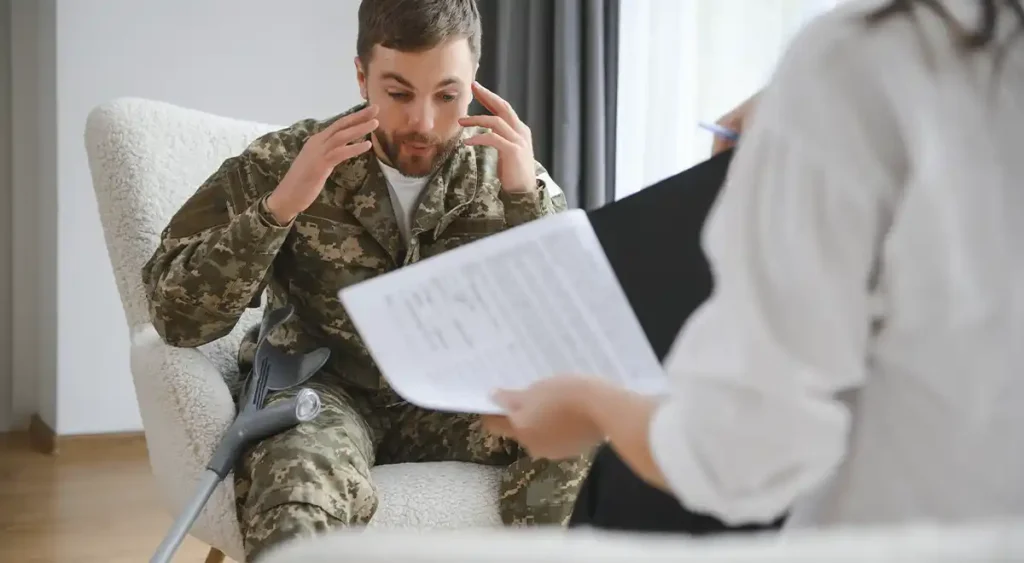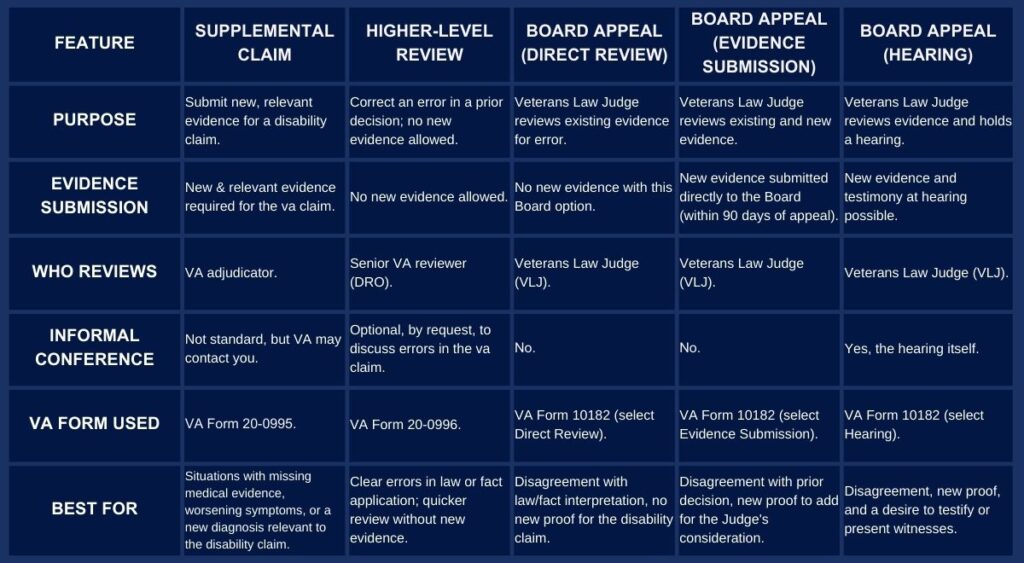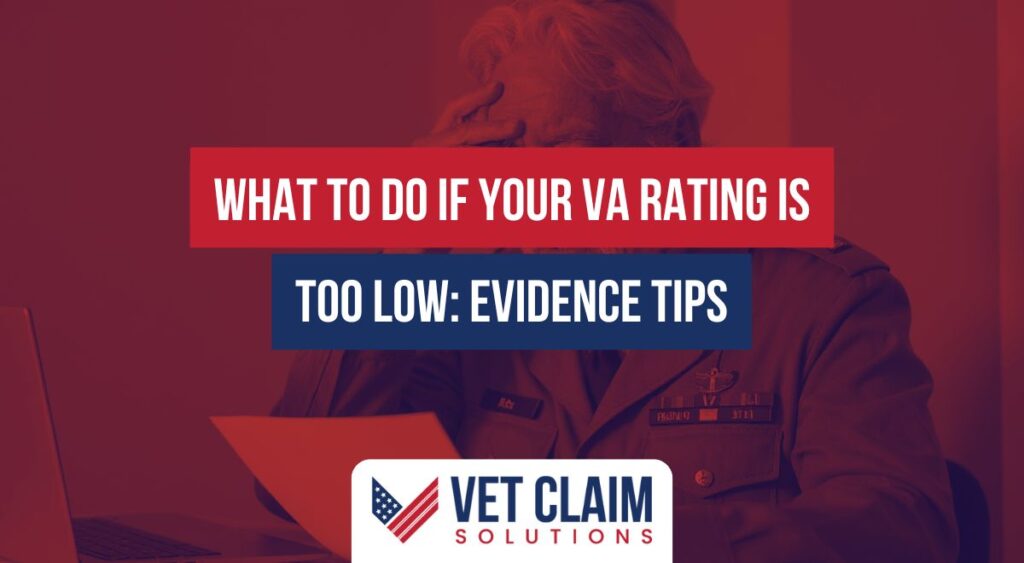That letter arrives. Your heart pounds a bit. You open it, hoping for good news about your VA disability claim. But then, disappointment hits. The disability rating is much lower than you expected. It’s a punch to the gut, isn’t it?
You served your country, and you know your conditions affect your daily life. So, what now? You’re probably wondering what to do if your VA rating is too low. This situation advises on gathering medical evidence and requesting reconsideration as vital next steps for your va claim.
Don’t lose hope. There are pathways forward, and understanding them is the first step. We’ll talk about what to do if your VA rating is too low, focusing on how gathering medical evidence and requesting reconsideration can help you fight for the disability benefits you deserve.

Understanding Your VA Rating Decision
Why did this happen? Sometimes, a low rating, or even a denied service connection, comes down to not enough medical proof. Maybe the Compensation and Pension (C&P) exam didn’t capture the full extent of your disability. Or perhaps the VA didn’t fully grasp how severe your service-connected condition is and how it impacts your ability to function.
Your VA rating decision letter is a critical document. Read every word carefully. It explains why they decided on your specific disability ratings. Look for the “Evidence” section; it lists what documents and medical records they reviewed. The “Reasons for Decision” part details their thinking for each disability claim.
This information helps you figure out what went wrong or what was missing from your initial claim. First, the VA determines if your condition is “service-connected.” This means they agree your military service caused or worsened your illness or injury. If it’s not deemed a service-connected disability, you won’t get disability compensation for it through that specific va claim, but you might still have options to prove service connection.
If service connection is granted, they then assign a disability percentage. This number, from 0% to 100% (in 10% increments), shows how much your disability impacts your average earning capacity. Higher percentages mean more disability compensation and potentially other va disability benefits. Understanding these basics helps you plan your next move for a rating increase.
First Steps After a Disappointing Rating
It’s completely normal to feel angry or let down by a low va disability rating. Take a moment to process these feelings. But don’t let those emotions stop you from taking action. Your fight for fair compensation benefits isn’t over.
Grab that decision letter again. Go through it with a fine-tooth comb. Are there any clear mistakes in fact or law? Did they overlook some critical evidence you sent, like specific private medical records or a crucial buddy statement? Understanding their justification is your starting point, as they must explain their decision based on the relevant evidence.
Think about what might have been weak in your original va claim. Was there enough medical evidence linking your condition to your military service? Did you fully explain how your symptoms affect your daily life and work capacity? Identifying these gaps will guide your strategy for getting that disability rating increased or establishing service connection if it was denied.
What to Do If Your VA Rating Is Too Low Advises on gathering medical evidence and requesting reconsideration.
This is where the real work begins for your va claim. You have avenues to challenge the VA’s decision. Most often, success in obtaining a rating increase hinges on stronger evidence and knowing which review process to choose for your appeal.
This is precisely where understanding what to do if your va rating is too low advises on gathering medical evidence and requesting reconsideration comes into play. Building a strong case involves compiling comprehensive evidence and selecting the most appropriate path for review or appeal. Success in increase requests often depends on this preparation.
The Crucial Role of Medical Evidence
Medical evidence is the backbone of any VA disability claim and is fundamental for a rating increase. It’s what demonstrates to the VA the reality and severity of your condition. Without solid medical proof, it’s very hard to win an increase to your disability rating or successfully appeal a denied va claim. You need to clearly show both the service connection (if still in dispute) and the current severity of your disability.

What kind of medical evidence matters most for your disability claim?
- Service Treatment Records (STRs): These are your medical records from your time in military service. They can show when an injury occurred, when symptoms first appeared, or in-service complaints that might establish a link for your service-connected disability.
- VA Medical Records: If you receive care at va medical facilities, these records document your ongoing treatment, diagnoses, and the current state of your condition. Consistent treatment at a VA medical center can create a strong trail of evidence.
- Private Medical Records: Records from civilian doctors and private medical healthcare providers are just as important. They can show diagnoses, treatments, opinions from specialists, and how your condition affects you outside of VA care. Submitting these private medical records is vital.
- Medical Opinions and Nexus Letters: These are statements from qualified medical professionals. A medical opinion can explain the severity of your condition, while nexus letters specifically connect your disability to your military service. A strong, well-reasoned nexus letter from a credible medical source can be incredibly powerful in establishing service connection or supporting an increased rating.
The VA relies heavily on medical evidence to assign ratings for service-connected conditions. The more detailed and consistent your medical record, the better your chances. It’s important to submit all relevant evidence VA might need.
Gathering New and Relevant Medical Evidence
If your disability rating is too low, you probably need more, or more specific, medical evidence. Don’t stop seeking treatment for your conditions; consistent medical care creates an ongoing record of your disability. This documentation can clearly show if your condition has worsened over time, which is a common basis for a rating increase. Updated medical evidence is key.
Consider seeing specialists for your conditions. A specialist’s medical opinion often carries more weight, especially for complex issues like traumatic brain injury or specific mental health conditions. They can provide detailed reports and test results that primary care physicians might not. For instance, an orthopedist’s detailed assessment of a knee injury would be more persuasive than general notes.
A strong nexus letter is invaluable, especially for establishing service connection or linking secondary conditions. This is a letter from a medical professional, such as your doctor or a specialist. It should clearly state that it’s “at least as likely as not” (the VA’s standard of proof) that your disability is due to your military service or accurately describe the severity of your current, service-connected disability based on objective findings. If your doctor isn’t sure how to write one, some veterans find help from organizations that connect veterans with doctors for independent medical opinions (IMOs).
When you secure updated medical records, make sure your doctor reviews your service medical records and your complete current medical records. This context helps them write more effective nexus letters or medical opinions. Keep track of everything. If your symptoms are getting worse, tell your doctor at every visit and make sure these worsening symptoms are documented in your treatment records. This updated medical evidence of worsening can be key to getting an increased rating.
The Role of C&P Exams in Your Rating
Compensation and Pension (C&P) exams are medical evaluations scheduled by the VA. They are a critical part of the va claim process. A VA-contracted or VA staff physician conducts these exams to gather information about your claimed conditions. The examiner will review your claim file, ask questions about your symptoms and history, and perform a physical examination if applicable.
The C&P examiner’s report significantly influences the disability rating the VA assigns. It’s important to be honest, thorough, and specific when describing your symptoms and how they affect your daily life and ability to work. Do not downplay your symptoms, but also do not exaggerate them. Explain the frequency, duration, and severity of your symptoms and provide concrete examples of how they limit you.

If you have a C&P exam scheduled, try to prepare. Review your medical records and make notes about your conditions. If possible, bring a copy of any new medical evidence that the VA may not have. After the exam, if you feel the examiner did not adequately capture your disability or seemed rushed, you can submit a statement to the VA detailing your concerns. You also have the right to request a copy of the C&P exam report to understand its impact on your rating decision.
Non-Medical Evidence That Can Help
It’s not all about doctor’s notes and treatment records. Other types of relevant evidence, known as lay evidence, can substantially support your va claim. Lay statements, also called “buddy statements,” can be very effective in painting a fuller picture of your disability. These are written statements from people who know you and have personally witnessed how your disability affects you.
Who can write a buddy statement? Your spouse, adult children, parents, friends, former colleagues, or fellow service members who served with you can. The letter should describe specific situations and how your condition limits your activities of daily living, social interactions, or ability to work. For example, if your back pain prevents you from lifting groceries or playing with your kids, your spouse could write a detailed lay statement about that. Vague statements like “he’s in pain often” are less helpful than detailed examples demonstrating the functional impact.
The VA provides VA Form 21-10210, Lay/Witness Statement, which can be used to structure these accounts. Such lay statements can be particularly helpful for conditions like PTSD or chronic pain, where the day-to-day impact isn’t always visible in clinical medical records. Buddy statements from service members who witnessed an in-service event or injury can also help establish service connection. These statements are a valuable part of submitting evidence.
If your disability impacts your ability to work, documentation about your work history can also serve as strong evidence. This might include letters from past employers detailing your job duties and why you could no longer perform them, or records showing job loss or changes due to your condition. This is especially true if you’re applying for Total Disability Individual Unemployability (TDIU) because your service-connected conditions prevent you from maintaining substantially gainful employment.
Understanding and Claiming Secondary Conditions
A secondary condition is an illness or injury that developed as a result of, or was worsened by, an already service-connected condition. For example, if you have a service-connected knee injury that causes you to walk with an altered gait, you might develop a secondary condition like hip or back pain. Depression or anxiety can also be claimed as secondary conditions if they arise due to the chronic pain and limitations of another service-connected disability.
Claiming secondary conditions can be a way to increase your overall combined rating. The VA rates secondary conditions just like primary service-connected conditions, assigning a disability rating based on severity. To successfully claim a secondary condition, you generally need medical evidence establishing a link, or nexus, between your primary service-connected disability and the new secondary condition. A nexus letter from a doctor explaining this connection is often crucial.
When filing a va claim for a secondary condition, you’ll need to provide medical records showing the diagnosis and treatment of the secondary condition. You also need to articulate how it’s connected to your primary service-connected condition. This process involves submitting evidence to demonstrate the link, much like an initial claim. Many veterans are unaware they can receive disability benefits for these related issues.
Your Options for Requesting Reconsideration or Appeal

Once you have more evidence or you think the VA made an error in your va claim, you need to choose the right path to ask for a review. The VA modernized its appeals system with the Appeals Modernization Act (AMA). Now, there are three main appeals options available if you disagree with a decision on your disability claim.
Supplemental Claim: Adding New Evidence
What is a Supplemental Claim? This is your go-to option if you have new and relevant evidence that the VA didn’t have when they made their prior decision. “New” means the VA hasn’t seen it before for this specific claim. “Relevant” means the evidence could potentially change the decision. A supplemental claim is filed using VA Form 20-0995.
When is this the best option? It’s perfect if your low disability rating was because of missing medical records, an absent or weak nexus letter, or if your service-connected condition has genuinely worsened since your last C&P exam or rating decision. You’re basically telling the VA, “Please review my claim again with this new proof.” You generally have one year from the date of your decision letter to file a supplemental claim to maintain your original effective date for benefits if the claim is granted. Filing a review supplemental claim appeal can be a good strategy for a rating increase.
The VA has a duty to assist you in gathering evidence for a Supplemental Claim. However, it’s always best if you can obtain and submit the new and relevant evidence yourself. This often speeds up the claims process for your va disability benefits. If you submit sufficient updated medical evidence, this is a strong path.
Higher-Level Review: Requesting a Senior Reviewer
What is a Higher-Level Review (HLR)? You choose this path if you believe the VA made a legal or factual mistake in reviewing the evidence they already had in your claim file. You’re asking for a more experienced VA adjudicator (a Decision Review Officer or DRO) to take a fresh look at your case. A higher-level review is filed using VA Form 20-0996.
A key point for a higher-level review: you cannot submit new evidence. The review is based solely on the record that existed at the time of the prior decision. If you have new evidence you want considered, a Supplemental Claim is the better route. During an HLR, you (or your representative) can request an informal phone call with the reviewer to point out the specific errors you believe were made in the decision on your disability claim.
When might you choose this option? Perhaps you feel the C&P examiner didn’t consider all your documented symptoms, or they misapplied the rating criteria for rating disabilities. Or maybe the VA applied a law incorrectly to your va claim. If you’re confident the evidence already submitted should have resulted in a higher disability rating, a higher-level review supplemental claim appeal is a good option for a faster review without new evidence submission.
Board Appeal: Taking Your Case to a Veterans Law Judge
What is a Board Appeal? This option sends your case to the Board of Veterans’ Appeals (BVA) in Washington, D.C. A Veterans Law Judge (VLJ), who is an attorney experienced in veterans law, will review your case. This is generally for more complex disagreements or if you’re not satisfied with the outcomes of a Supplemental Claim or Higher-Level Review. A Board Appeal is filed using VA Form 10182, Notice of Disagreement.
There are three dockets, or paths, you can choose when appealing to the Board:
- Direct Review: The VLJ reviews the same evidence the VA regional office had. No new evidence can be submitted, and there is no hearing. This is generally the fastest of the three Board dockets for your claim appeal.
- Evidence Submission: You can submit new evidence directly to the Board within 90 days of filing your appeal using this docket. There is no hearing with the Veterans Law Judge. The VLJ will review the existing record plus the new evidence you submit.
- Hearing: You can submit new evidence (before or at the hearing, or within 90 days after) and request a hearing with a VLJ. This hearing evidence can be testimony from you and witnesses. Hearings can be virtual from your home, via video-teleconference at a local VA office, or in person in Washington D.C. This docket usually takes the longest to resolve.
Board Appeals can take more time compared to other appeal options. It’s a significant step, and many veterans choose to have representation from a Veterans Service Officer (VSO), an accredited agent, or an attorney at this stage of the veterans appeals process. You can learn more about the different appeal options on the VA’s website to see which might fit your situation best as you seek to secure benefits.
Here is a table summarizing the VA’s main appeal options:

Tips for Strengthening Your Case
No matter which path you choose for your rating increase requests, here are some things to keep in mind. Always be specific in your statements, VA form submissions, and any testimony. Don’t just say “my back hurts.” Describe when it hurts, how much (e.g., on a pain scale), what makes it worse, what, if anything, makes it better, and how it stops you from doing specific things in your daily life.
Connect the dots for the VA. Clearly explain how your disability relates to an event, injury, or disease during your military service, especially if service connection is an issue. Show the impact. Tell them how your disability affects your daily routines, your ability to work, your social life, and your relationships. The VA needs to understand the functional impairment your service-connected disability causes. Developing a strong case often means detailing these impacts.
And always, always keep copies of every single thing you send to the VA and everything they send you. Create a well-organized claim file for your records. Stay organized with your medical records and correspondence. This will help you manage the claims process effectively and have all necessary documents readily available when discussing your va claim with representatives or VA personnel.
Deadlines are incredibly important in the VA system for veterans appeals. Missing a deadline can mean losing your right to appeal or losing out on retroactive disability benefits (back pay). Pay close attention to the dates on your decision letters.
The Importance of Understanding VA Math for Combined Ratings
Here’s something that confuses many veterans when looking at their va disability rating. VA math for calculating a combined rating is not simple addition. If you have a 30% rating for PTSD and a 20% rating for a knee condition, your combined rating isn’t automatically 50%. The VA uses a “whole person theory” to determine combined disability ratings.
They start with 100% (representing a whole, healthy person). For each disability, they calculate the percentage of disability, then apply that to the remaining “healthy” percentage of the person. So, for a 30% PTSD rating, they take 30% from 100%, leaving the veteran 70% “efficient” or “healthy.” Then, for the 20% knee condition, they take 20% of the remaining 70%, which is 14%. This 14% is then added to the initial 30%, giving a combined disability of 44%.
The VA then rounds this combined rating to the nearest 10%. So, a 44% would be rounded down to a 40% combined rating. The VA provides tables and explanations for this calculation, but it can still be tricky. Knowing how combined ratings work helps you have realistic expectations as you seek increases for individual disability ratings and understand how each one contributes to your overall va disability compensation.
Don’t Give Up: Persistence Pays Off
The VA claims process and the subsequent appeals options can feel like a marathon, not a sprint. It’s easy to get discouraged, especially after receiving a low initial va rating or a denial of your disability claim. But please know, many veterans have been in your shoes and have successfully gotten the disability rating and compensation benefits they deserve through persistence and by submitting the right evidence.
Don’t take “no” or “too low” as the final answer if you believe your service-connected conditions warrant a higher rating or if you believe a denied claim should be service-connected. Gather your medical evidence and lay evidence. Understand your appeal options. File the right VA form and submit all necessary documentation within the deadlines. It’s your right to pursue the va disability benefits you earned through your military service.
Remember, every piece of relevant evidence, every correctly filed form for a supplemental claim or higher-level review, brings you one step closer. Your health and well-being are worth fighting for. Keep going, and consider seeking assistance from professionals who understand the VA claims process to help build your strong case and secure benefits.

Conclusion
Receiving a VA rating that feels too low is a tough experience. It can make you feel unheard and undervalued after your military service. But it’s not the end of the road for your disability claim.
Understanding what to do if your VA rating is too low advises on gathering medical evidence and requesting reconsideration. This understanding empowers you to take control of your va claim. By carefully collecting strong medical evidence, including updated medical records and nexus letters, and relevant lay statements, and by choosing the correct VA review lane—be it a Supplemental Claim, Higher-Level Review, or Board Appeal—you can significantly improve your chances for a more accurate and fair disability rating.
Your service earned these potential disability benefits; now it’s time to make sure the VA fully recognizes your sacrifice and the current impact of your service-connected condition. Persistence in the claims process, coupled with a well-supported case, can lead to the disability compensation you are entitled to receive.


